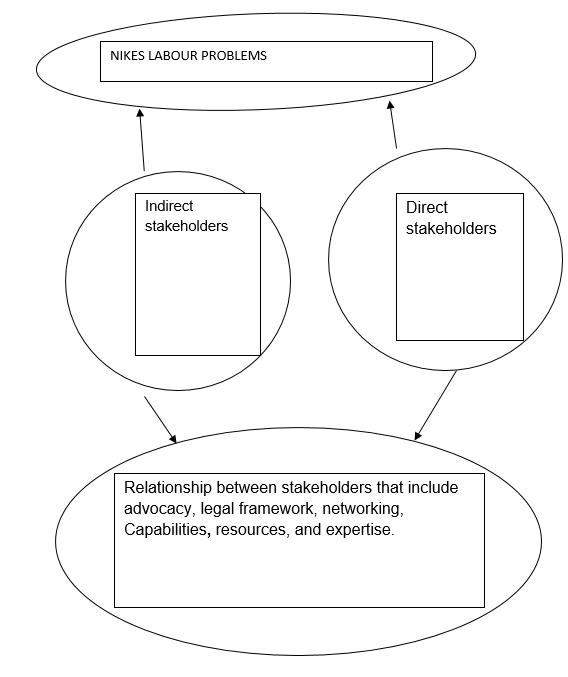Nike, Inc is one of the largest companies that deal with sportswear, clothing, footwear, and supply equipment. The organization is based in the USA but has a global presence. Although the company has been performing well in the market, it has been facing labor problems. Labor problems mostly occur in third world countries such as China and Vietnam, where there is easy access to abundant low-priced labor.
The labor-related problems faced by Nike are child labor, poor working conditions, and promoting the unethical use of cheap labor. Basing on the labor problems that have bedeviled the company for years, analysis of the relationship among indirect and direct stakeholders basing on four interest points; economics, ecology, biology, and society is essential in developing a mind map that is important in scrutinizing the problems and developing solutions to the problems.
The direct stakeholders of Nike are the company management, employees, retailers, consumers, athletes, governments, suppliers, athletic associations, and the employees of the organization’s chain supply. The indirect stakeholders are trade unions, Non-Governmental Organizations, academics, and the media (Ballinger, 2001). Basing on the labor problems and the four stakeholder interest, several relationships exist among the stakeholders. The major connections are;
- Advocacy: This is a process involving a large group, whose aim is to influence the allocation of resources, influence policies that have a direct effect on the public, and fighting for human rights especially the treatment of employees. Basing on the labor problems facing Nike, the main stakeholders are the employees, media, nongovernmental organizations, trade unions, governments, retailers, and the company management. Nongovernmental organizations and trade unions have been fronting for the rights of the employees because Nike has been engaging the services of cheap labor thus denying the employees their rights to good financial prospects. Most governments from the poor country have been supporting the activities of Nike and do not pay attention to any violation of the rights of the poor employees. As such, the management of the company got the courage of engaging in labor malpractice without fear of reprisal from the governments. The media has played a key role in highlighting labor problems and airing the employee’s rights advocacy to the public. The stakeholder interest, in this case, is society since it deals with the social life of the workers, who are oppressed financially which in turn affects their social status. The biological interest involves a worker’s union from different countries cooperating and assisting each other in fighting for the rights of the labor force. Through advocacy, the ecological interest has been fulfilled because a good working environment has been created (Sage, 1999).
- Networking: This is an economic and social activity where people of the same interest create, recognize business opportunities, and act upon them. The networking between the management of Nike and Government officials in third world countries has played a key role in the increased use of cheap labor and child labor. Most of the governments in third world countries do not have concrete policies and laws that govern the treatment of child labor. Networking between trade unions in third world countries and the USA has played a key role in highlighting the unethical labor practices by Nike and has been essential in the decision by the organization to transform its labor rules (Ballinger, 2001).
- Capabilities, resources, and expertise: These are very important links between stakeholders as they define the economic, ecological, biological, and social interest of both direct and indirect stakeholders. The employees are the major aspects of human resources as their capability and expertise contribute greatly to organizational success. In the case of Nike labor problems, the use of child labor and cheap labor undermine this connection because the organization gains more resources as a result of oppression. The stakeholders involved here are the employees and the management (Sage, 1999).
- The legal framework offers a platform for rules, laws, policies, and directives related to the labor force. Nike has been facing labor problems in the US due to strict labor laws but its branches in other countries breach these laws and engage in legal malpractices such as child labor. This has attracted several legal lawsuits from stakeholders such as labor unions and non-governmental organizations (Ballinger, 2001).
Basing on the relationship between direct and indirect stakeholders, a mind map created shows issues that are related to Nike’s labor problems.

Limitations
The mind map does not show the engagement of different stakeholders in addressing the problems. As such, issues such as mediation, specific legal suits, and the role of social responsibility on the issue are not well explained. This may be because Nike has a global presence and the problems are handled differently in different countries. Also, since there are many stakeholders, the relationship between them does not fully show how each stakeholder has either fuelled or fought to eradicate the problems (Buzan, 2000).
References
Ballinger, J. (2001). “Nike’s Voice Looms Large”. Social Policy 4 (6): 33-39.
Buzan, T.(2000). The Mind Map Book, New York: Penguin Books.
Sage, H. (1999). “Justice Do It! The Nike Transnational Advocacy Network: Organization, Collective Actions, and Outcomes”. Sociology of Sport Journal 16: 206-235.